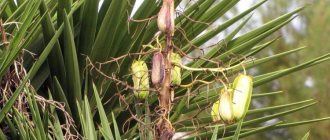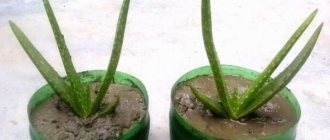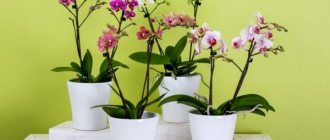Plants from the Orchid family grow almost all over the globe. There are types of orchids that exist in warm, tropical climates, and there are those that feel quite good in the temperate climate of the northern hemisphere. In indoor and decorative floriculture, you can most often find hybrid orchids and species from the genera:
- phalaenopsis
- dendrobium
- cattleya
Orchids are very ancient plants; over many hundreds of thousands of years of existence, they have adapted very well to various living conditions. They are characterized by mimicry, which attracts pollinators, symbiosis of the embryo with protozoan fungi to receive carbohydrates from them for growth and development, and the formation of pseudobulbs for water storage and vegetative propagation. Let's learn how to plant an orchid bulb or pseudobulb at home.
Peculiarities
The Vietnamese orchid is a bulbous plant. Under natural conditions, the crop grows on the trunks of giant trees. The most suitable climate for such orchids is a high level of air humidity, as well as a large amount of light.
There are two types of orchids found in Vietnam:
- terrestrial - grow in areas where garbage and humus accumulate, are distinguished by bright colors and large dense leaves;
- aerial - grow on the trunks of crops, the buds grow downwards and are distinguished by a light, delicate aroma.
Reference ! Only the orchid bulb can be brought from Vietnam; it will not be possible to bring a flowerpot from this country.
Care
In order for the bulb of a Vietnamese orchid to germinate, it is important to create suitable conditions for it. It will germinate if the room is hot. Air humidity should be high . The light is scattered. It is better to place the bottle with it on a window facing south.
- The optimal day and night temperatures are +18 and above +20 degrees Celsius, respectively.
- Air humidity – 60%.
- Watering is not required in the first month after planting, but later the plant is watered in the morning by immersing it in a container of water (40⁰C).
Below you can watch a video on how to care for such an orchid:
Source: dacha.expert
Types of Vietnamese bulbous flowers: names, descriptions and photos
The most popular types of Vietnamese crops are the following.
Beautiful
The buds grow up to 8 cm in diameter . The petals are distinguished by a green-orange hue with dark inclusions in the form of dots and stripes.
Siamese
A characteristic feature is that only one green-pink bud can bloom on one peduncle.
Vietnamese
A distinctive characteristic is the lower flowers, which can be of very different colors. The lower petals look like shoes.
Single-flowered
This type of orchid blooms earlier than other subspecies. The peduncle grows low. Usually no more than 2 flowers grow on a peduncle , up to 7 cm in diameter.
Appleton
It is distinguished by large buds growing up to 10 cm in diameter, combining brown and purple colors.
Bearded
It is distinguished by burgundy petals with a white (sometimes milky or light yellow) border.
Elena
This type of orchid blooms for 100 days . The flowers are yellow. It seems that the petals are covered with wax.
Where and for how much can I buy it?
Vietnamese orchids can be found in large flower shops. Also, such varieties are presented in a wide range in online stores. There, the cost of a plant starts from 900 rubles. Delivery price depends on the region.
If you are directly in Vietnam, then you can safely go to any flower shop. There you can choose from a variety of products to suit your taste and budget. But do not forget that you only need to purchase the bulb.
Cheaper plants can be found in flower markets in Vietnam. There the assortment will be more varied. The most affordable prices are at the Cho Dam market in Nha Trang .
Step-by-step landing instructions
Why will it be needed?
- If you brought a bulba from the store, you need to immediately transplant it into the ground. Otherwise, the bulb will die without producing a single root.
- If you purchased a small shoot of an orchid, then it also needs to be transplanted into another container to avoid rotting of the crop.
- In addition, as the plant grows and develops, the acidity of the soil decreases, so it needs to be updated. If there is no replanting, the substrate will become dense, causing its decomposition and slowing down root growth.
- If orchids grow in a bark substrate, then the frequency of replanting is every 3 years. When planting in sphagnum, the substrate is changed every 2 years.
You should not wait for the transplant schedule in the following cases::
- the crop has begun to rot (usually due to excessive watering);
- pests and diseases appeared in the substrate;
- soil decomposition occurs.
What inventory do you need?
From the inventory you will need the bulb itself or the shoot of the plant, a flowerpot (necessarily transparent), as well as a substrate.
Reference ! To begin with, do not buy a large flowerpot. A pot with a diameter of 10 cm will be sufficient.
How to prepare the soil?
It is best to purchase a ready-made substrate . Make sure it contains the following components:
- sphagnum moss;
- bark (coniferous trees only);
- coconut chips.
It is also recommended to supplement the purchased mixture with rockwool fiber.
But you can prepare the soil mixture yourself. To do this you need to take the following components:
- pine needle bark (take only one that has been cleared of resin);
- charcoal ;
- sphagnum moss;
- peat;
- sand (preferably river sand, as it is coarser);
- expanded clay for the drainage layer (can be replaced with perlite or broken brick).
All components must be thoroughly mixed to increase their aeration. You can also add chalk or lime to increase the calcium content in the soil.
How to plant correctly?
Algorithm for planting Vietnamese orchid bulbs:
- Moisten the soil mixture well.
- Place stones at the bottom of the flowerpot and pour expanded clay (this will be a drainage layer).
- Pour the substrate almost to the very top of the pot.
- Place the bulb in the pot, install it in the soil, deepening it 10-15 mm.
- Support the onion with a stick to secure it.
- Place the flowerpot in a bright place.
Reference ! The Vietnamese orchid is not watered until the roots appear.
Reproduction of orchids by children
This method is most relevant for the most common orchids of the phalaenopsis species.
It is these plants that reproduce very readily even without additional intervention from the grower. Reproduction of orchids at home with the help of children can be provoked by hormonal pastes containing cytokinins. However, children often appear in the roots and on the trunk of the plant itself. This paste contains phytohormones - cytokinins, which accelerate the plant's metabolism and enhance the growth of new shoots and buds. However, it should only be used on healthy and mature plants.
The natural appearance of babies in orchids is possible immediately after flowering. The upper or middle bud on the peduncle awakens and produces either new growth or a new shoot. Read on to learn how to propagate orchids using paste.
Baby on a peduncle
In order to get a baby on a peduncle, you can use cytokinin paste. The action plan will be as follows:
- Using a sterile instrument, it is necessary to bend back the scales covering the dormant bud.
- Use a heated needle or clean toothpick to scratch the plant tissue next to it.
- Apply the paste to the dormant bud in a volume the size of a pinhead.
- The awakening of the kidney can be observed on days 7-10.
Propagation using orchid paste can result in the formation of 2-3 new shoots from one bud. Such mutations are very harmful to the aesthetic appearance and lead to severe stress on the mother plant. This can happen both due to an overdose of hormonal paste, and due to genetic pathologies in development. It is difficult to say how strong or weak the baby will be, but, according to numerous reviews from flower growers, the offspring after cytokinin paste are an order of magnitude weaker, and the flowering is not as lush as that of the mother.
Another important point when propagating orchids by children is the need for proper rooting of the child. Quite often, young growths are in no hurry to build up the root system, but they push out new leaves one after another and may even bloom. This situation has a negative impact on the mother; she may not have enough strength to feed the baby.
A good way to quickly grow roots in young plants is to create a cushion of moss or so-called planting in a pot directly on the mother’s peduncle. For this we need:
- A small pot with a diameter of 2.5 cm or a cut plastic bottle of 0.5 liters.
- Scissors.
- Scotch.
- Sphagnum moss.
- Pin.
At the bottom of the pot we make a hole for the diameter of the peduncle. Using scissors, we cut the pot vertically down to the hole and wrap the pot around the peduncle so that the baby is ¾ of the way up to the pot. Secure the container from below with a clothespin. We glue the walls of the pot together with tape and put sphagnum moss inside, after moistening it with water and a rooting agent. A good drug for this is Kornevin - it is accessible and inexpensive.
This method adapts young plants well to independent life, and the undoubted advantage is that the orchid immediately learns to feed on roots, which reduces stress during transplantation. Among other things, flower growers note a positive point in the fact that the roots immediately grow inside the pot and the transplant will be less traumatic.
Root baby
Basal children, or as they are also called, basal, can appear in monopodial orchid species. Most often they begin to grow in phalaenopsis, but it is impossible to induce an orchid to this type of reproduction. As a rule, a basal baby appears when the mother plant is in danger and the plant does not want to interrupt its life cycle.
Experienced gardeners categorically do not recommend smearing the trunk of healthy phalaenopsis with cytokinin paste - this method can be detrimental to the plant.
Problems and difficulties
Most often, the planted bulb is attacked by thrips, mites, and roundworms. To get rid of thrips, you need :
- isolate the plant;
- rinse the onion under running water;
- and then treat with insecticides.
If the orchid is attacked by nematodes, it will not be able to be revived.
If you notice that the crop has begun to wither, but no pests are visible on it, lower the flowerpot with the flower into soda water.
Transplantation
Orchids need to be replanted frequently, because the substrate quickly deteriorates, it becomes too dense, and its acidity changes. So flowers growing on sphagnum are replanted every two years, on bark every three years. Sometimes you have to do this more often if pests appear, if the substrate clearly begins to deteriorate (which can be indicated by an unpleasant odor), if improper watering has led to rotting of the roots. The best time for this is spring, when the flower grows most actively.
For transplantation, take new transparent dishes of a slightly larger size and a new substrate. In the same way, stones and a drainage layer are placed on the bottom, then the substrate itself is placed. The flower is watered abundantly so that it can be removed without causing the slightest harm. Sometimes you have to sacrifice an old pot; it is broken or cut if the substrate has become so compacted that even after watering it is not possible to remove the plant. The roots of the plant are placed in warm water to completely free it from the old substrate. If there are damaged or rotten roots or leaves, they should be carefully cut off and the cut areas should be sprinkled with crushed coal.
The plant is placed in a new pot, the substrate is added, lightly tapping the pot so that it is better distributed. After planting, water the plant; if moisture gets on the growing point, it is better to get it wet. The root collar should be above the substrate, a centimeter below the edge of the pot.
How to grow at home?
In order for the Vietnamese orchid to develop quickly and fully, it needs to be provided with optimal conditions:
- the air temperature should fluctuate between 18-24 degrees above zero;
- maintain air humidity at 70-85% (do not allow humidity to drop to 50% or lower);
- every month apply a complex fertilizer intended specifically for orchids;
- in summer, water every day, and in winter - once a week after the top layer of soil has completely dried;
- place the pot with the orchid in a lighted place, but at the same time protect it from direct sunlight;
- in winter, arrange additional lighting.
The orchid from Vietnam is a magnificent plant that attracts everyone's eye. The culture does not require special care. The most important thing is to follow all recommendations regularly and systematically.
Propagation of orchids by cuttings
In order to propagate an orchid by cuttings, you need to know for which species this method is suitable. Oddly enough, both sympodial and monopodial species can be propagated by cuttings. In the first case, cuttings will be carried out with a pseudobulb, and in the second - with peduncles.
The best results of this type of propagation are produced by dendrobiums and phalaenopsis. However, there are also negative experiences, since the result depends on many factors: environment, lighting, and most importantly, the genetic characteristics of the orchid. Experienced gardeners also do not recommend using cymbidiums, cattleyas and other more expensive species for this.
So what should you do to propagate from cuttings?
- We will need a peduncle or pseudobulb. The peduncle can be cut off after it begins to dry out, and the pseudobulb can be taken from any faded dendrobium.
- We will need a mixture of fine bark and sphagnum moss.
- Sections of peduncles can be dried, sections of pseudobulbs can be treated with phytosporin or filled with paraffin.
- We place the prepared substrate in a greenhouse and place the cuttings there.
- As the substrate dries, it should be moistened with a spray bottle. The temperature should be maintained at 23-25 degrees, there should also be diffused light and regular ventilation.
The first results can be seen within 1-2 weeks. Dormant buds may awaken on the peduncles of phalaenopsis, and new shoots may appear on the pseudobulbs of dendrobium, which will eventually become babies.











